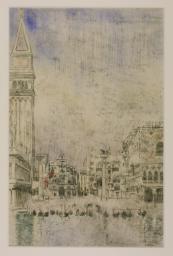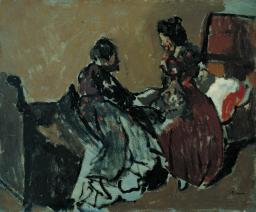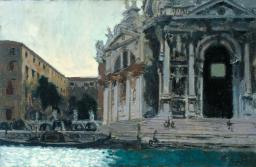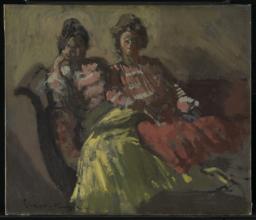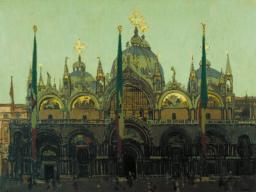Walter Richard Sickert Interior of St Mark's, Venice 1895-6
Walter Richard Sickert,
Interior of St Mark's, Venice
1895-6
This ambitious work depicts much of the complex, vaulted interior of St Mark’s Basilica in Venice, with the archway and mosaics of the Chapel of St Isidore visible on the left. Observed halfway down the right side of the nave, looking towards the iconostasis and apse receding in the distance, Sickert’s low-angled view may have been painted in situ, as the lack of composition lines and loose, fluid brushstrokes suggest. The picture’s restricted palette emphasises the low lighting conditions, with carefully controlled highlights indicating the gilded accents, mosaics and lamps above.
Walter Richard Sickert 1860–1942
Interior of St Mark’s, Venice
1895–6
Oil paint on canvas
698 x 492 mm
Inscribed by the artist ‘Sickert’ bottom left
Purchased from Howard Bliss (Knapping Fund) 1941
N05314
1895–6
Oil paint on canvas
698 x 492 mm
Inscribed by the artist ‘Sickert’ bottom left
Purchased from Howard Bliss (Knapping Fund) 1941
N05314
Ownership history
... ; purchased from Mrs Cicely Marchant through the French Gallery, London, by Howard Bliss 1932, from whom purchased by Tate Gallery 1941.
Exhibition history
1929
?Retrospective Exhibition of Paintings and Drawings by Richard Sickert ARA, PRBA, Leicester Galleries, London, June 1929 (79, as ‘Interior San Marco’).
1932
Contemporary Paintings, Drawings and Sculpture, French Gallery, London, May–June 1932 (5).
1938
Paintings by Walter Richard Sickert, Arts Club of Chicago, January 1938 (16).
1938
Walter Richard Sickert: An Exhibition of Paintings, Department of Fine Arts, Carnegie Institute, Pittsburgh, February 1938 (18, as ‘Interior, St Mark’).
1940
British Painting since Whistler, National Gallery, London, March–August 1940 (186).
1941
Sickert Exhibition, National Gallery, London, August–December 1941 (54).
1942
The Tate Gallery’s Wartime Acquisitions, National Gallery, London, April–May 1942 (119).
1942–3
A Selection from the Tate Gallery’s Wartime Acquisitions, (Council for the Encouragement of Music and the Arts tour), Royal Exchange, London, July–August 1942, Cheltenham Art Gallery, September 1942, Ashmolean Museum, Oxford, October 1942, Galleries of Birmingham Society of Arts, November–December 1942, Fitzwilliam Museum, Cambridge, January–February 1943, Victoria Art Gallery, Bath, February–March 1943, National Museum of Wales, Cardiff, March–April 1943, Manchester City Art Gallery, April–May 1943, Philharmonic Hall, Liverpool, May–June 1943, National Gallery of Scotland, Edinburgh, June 1943, Glasgow Museum and Art Gallery, Kelvingrove, July 1943, Laing Art Gallery, Newcastle upon Tyne, August 1943 (81).
1946–7
Modern British Pictures from the Tate Gallery, (British Council tour), Palais des Beaux-Arts, Brussels, January–February 1946 (85), Stedelijk Museum, Amsterdam, March 1946 (85), Raadhushallen, Copenhagen, April–May 1946 (85), Musée du Jeu de Paume, Paris, June–July 1946 (85), Musée des Beaux-Arts, Berne, August 1946 (88), Akademie der Bildenden Kunste, Vienna, September 1946 (89), Narodni Galerie, Prague, October–November 1946 (89), Muzeum Narodwe, Warsaw, November–December 1946 (89), Galleria d’Arte Moderna, Rome, January–February 1947 (89), Tate Gallery, London, May–September 1947 (5314).
1950
British Art: The Last Fifty Years 1900–1950, English Speaking Union tour of USA, opened New York, October 1950 (30, reproduced).
1960
Sickert: Paintings and Drawings, (Arts Council tour), Tate Gallery, London, May–June 1960, Southampton Art Gallery, July 1960, Bradford City Art Gallery, July–August 1960 (75).
1989–90
W.R. Sickert: Drawings and Paintings 1890–1942, Tate Gallery, Liverpool, March 1989–February 1990, Tate Gallery, London, July–September 1990 (24, reproduced).
1992–3
Sickert: Paintings, Royal Academy, London, November 1992–February 1993, Van Gogh Museum, Amsterdam, February–May 1993 (22, reproduced).
1998
Two British Impressionists: Walter Sickert and Philip Wilson Steer, Norwich Castle Museum, January–April 1998 (23, reproduced).
2004
Walter Richard Sickert: The Human Canvas, Abbott Hall Art Gallery, Kendal, July–October 2004 (6, reproduced).
2009
Sickert in Venice, Dulwich Picture Gallery, London, March–May 2009 (8, reproduced).
2010
The Art of Walter Sickert, The Lightbox, Woking, May–July 2010 (no catalogue).
References
1938
Carnegie Magazine, vol.11, no.9, 1938, reproduced p.260.
1949
Carlos Peacock, Painters and Writers, London 1949, reproduced pl.82.
1958
John Rothenstein, The Tate Gallery, London 1958, reproduced.
1960
Lillian Browse, Sickert, London 1960, pp.26, 101.
1961
John Rothenstein, Sickert, London 1961, reproduced pl.3.
1964
Mary Chamot, Dennis Farr and Martin Butlin, Tate Gallery Catalogues: The Modern British Paintings, Drawings and Sculpture, vol.2, London 1964, p.636.
1973
Wendy Baron, Sickert, London 1973, pp.50–1, 314, no.87, reproduced pl.59.
1989
Kenneth McConkey, British Impressionism, London 1989, p.117, reproduced pl.107.
2006
Wendy Baron, Sickert: Paintings and Drawings, New Haven and London 2006, no.100, reproduced.
Technique and condition
Interior of St Mark’s, Venice is painted on a fine plain-weave linen canvas that was probably pre-primed and stretched by an artists’ colourman. The canvas has been prepared with sizing and an off-white primer that covers the extent of the canvas and is reasonably thin, retaining the finely grained texture of the cloth.
The artist has applied a thin layer of grey paint over the commercial primer to function as an optical ground; it is left exposed in places by the subsequent painting process, and appears to have been brushed on randomly, producing a texture independent of the final image. Initial drawing appears to have been carried out in black paint applied directly on to the grey ground, with no evidence of any underdrawing in graphic media. The artist has applied at least two layers of paint onto the optical ground, working in a limited range of colours, low in tone. The liquid scumbles of paint are thinly applied allowing the grey ground to alter the tone of the overlying layers and in places leaving it completely exposed to function as a neutral mid-tone (a so-called mid-ground technique). Earlier applications were probably allowed to dry before further painting (see also Tate N05914).
Sickert has used the texture of the canvas and the paint surface to vary his application and retain a sense of spontaneity. There are areas of broken brushwork where a stiff brush has bounced across the dry surface and occasional brush hairs are left in the paint where the artist has worked vigorously over partly dried paint. In general he has pre-mixed his colours on the palette, but there are touches that appear unresolved, the bright blue paint in the foreground, for example. The painting has been varnished and, at some point during its history, lined, which has slightly affected the painting’s surface qualities but has not reduced the display of technical skill in this work.1
Stephen Hackney
June 2004
Notes
How to cite
Stephen Hackney, 'Technique and Condition', June 2004, in Robert Upstone, ‘Interior of St Mark’s, Venice 1895–6 by Walter Richard Sickert’, catalogue entry, May 2009, in Helena Bonett, Ysanne Holt, Jennifer Mundy (eds.), The Camden Town Group in Context, Tate Research Publication, May 2012, https://wwwEntry
During his visit to Venice in 1895–6, Walter Sickert wrote to his friend Philip Wilson Steer that ‘on cold days I do interiors in St Mark’s ... St Mark’s is engrossing’.1 His aim, he said, was to emulate Steer’s own technique:
To see the thing all at once. To work open and loose, freely, with a full brush and full colour. And to understand that when, with that full colour, the drawing has been got, the picture is done.2
These comments suggest that Sickert made a number of pictures of the interior of St Mark’s, but only one other painting in oils is known, Church Interior with a Figure in a Niche 1895–6 (private collection),3 an oil study of part of the apse. A pencil drawing exists of a third composition, Interior of San Marco, Venice 1895–6 (private collection),4 which shows the basilica filled by its congregation, viewed from a balcony.
The loose painting and free handling of Interior of St Mark’s, Venice suggest that Sickert might well have painted it in situ. Unlike the small studies of the exterior of St Mark’s that he made (see Tate N05914), this is a relatively large canvas that would require an easel to support it. There are no suggestions of composition lines under the paint surface, or squaring up, and so the implication is that Sickert painted the interior from sight, a considerable achievement. Sickert’s position is halfway down the right side of the nave, looking towards the iconostasis and apse, but also allowing a dual perspective on the left up to the mosaics of the Chapel of St Isidore. It is a complicated and ambitious perspective that manages to include much of the interior all at the same time, and gives a sense of the complex vaulting of St Mark’s. The viewpoint is relatively low, suggesting Sickert was seated. Although painted in subdued, restricted colours, Sickert conveys the glitter of mosaics and gilding, and lamps above, with carefully controlled highlights. He was preoccupied with conveying in touches of paint the effects of both natural and artificial light. The art historian Wendy Baron has drawn comparison with the pictures of the Old Bedford music-hall balcony Sickert made before leaving for Venice.5 While Interior of St Mark’s, Venice is more expansive in its composition, the viewpoint looking up, the handling of paint, rich colouring and extravagant architecture all hold strong resonance with the Old Bedford pictures.
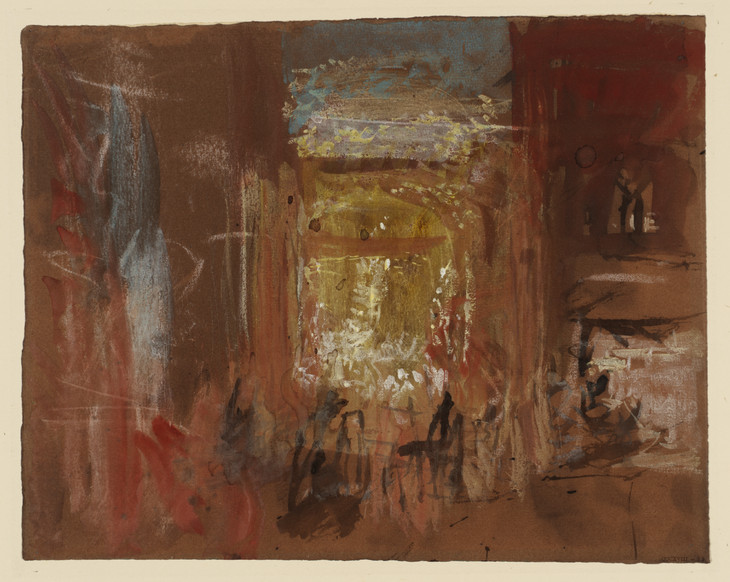
Joseph Mallord William Turner 1775–1851
Venice: The Interior of San Marco: the Atrium Looking North circa 1840
Chalk, gouache and watercolour on paper
support: 243 x 304 mm
Tate D32241
Accepted by the nation as part of the Turner Bequest 1856
Fig.1
Joseph Mallord William Turner
Venice: The Interior of San Marco: the Atrium Looking North circa 1840
Tate D32241

Joseph Mallord William Turner 1775–1851
Venice: The Interior of San Marco, Looking into the North Transept circa 1840
Gouache and watercolour on paper
support: 296 x 223 mm
Tate D32226
Accepted by the nation as part of the Turner Bequest 1856
Fig.2
Joseph Mallord William Turner
Venice: The Interior of San Marco, Looking into the North Transept circa 1840
Tate D32226
Another arresting similarity is to the series of studies J.M.W. Turner made in St Mark’s in the mid-nineteenth century (see, for instance, figs.1 and 2).6 Executed in gouache on brown paper, these works have a strong resemblance to Sickert’s oil, as they too are painted in loose, fluid brushstrokes, and have the same sort of low-key palette accented with highlights. Turner’s works on paper were displayed at the National Gallery in a series of selections made by John Ruskin in the closing decades of the nineteenth century.
Interior of St Mark’s, Venice was acquired in 1937 through one of Sickert’s dealers, The French Gallery, by Howard Bliss (1894–1977). An accomplished musician, he was the younger brother of the composer Arthur Bliss. He was an avid collector who built an important collection of modern British pictures. In particular, he was a passionate advocate and collector of the painter Ivon Hitchens, and arranged a number of exhibitions of his work throughout the country. After 1945 Bliss began to collect the work of unknown younger artists, often students, painting in an advanced style,7 and he purchased pictures by Patrick Heron, Peter Lanyon, William Scott and John Craxton. In 1950 he held an exhibition at the Leicester Galleries, London, so he might sell off works to make space for new ones.8 ‘I would rather be a collector,’ Bliss confessed in the catalogue introduction, ‘than the owner of a collection.’9 He wrote here that the collection ‘was begun seven years ago’, in 1943, but Sickert’s Interior of St Mark’s, Venice was acquired some years before and was therefore perhaps one of the earliest pictures he purchased.
Robert Upstone
May 2009
Notes
Walter Sickert, letter to Philip Wilson Steer; quoted in Robert Emmons, The Life and Opinions of Walter Richard Sickert, London 1992, p.107.
Reproduced in Wendy Baron, Sickert: Paintings and Drawings, New Haven and London 2006, no.100.1 and British and Irish Traditionalist and Modernist Paintings, Watercolours, Drawings and Sculpture, Christie’s, London, 10 June 1988 (358).
Baron 2006, no.100.2; reproduced in Modern British and Irish Paintings etc., Sotheby’s, London, 8 March 1995 (70).
Turner in Venice, exhibition catalogue, Tate Britain, London 2004, pls.120 and 121. See Robert Upstone, Sickert in Venice, exhibition catalogue, Dulwich Picture Gallery, London 2009, p.16.
Related biographies
Related catalogue entries
How to cite
Robert Upstone, ‘Interior of St Mark’s, Venice 1895–6 by Walter Richard Sickert’, catalogue entry, May 2009, in Helena Bonett, Ysanne Holt, Jennifer Mundy (eds.), The Camden Town Group in Context, Tate Research Publication, May 2012, https://www



